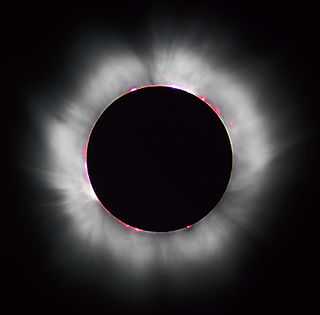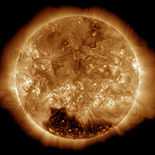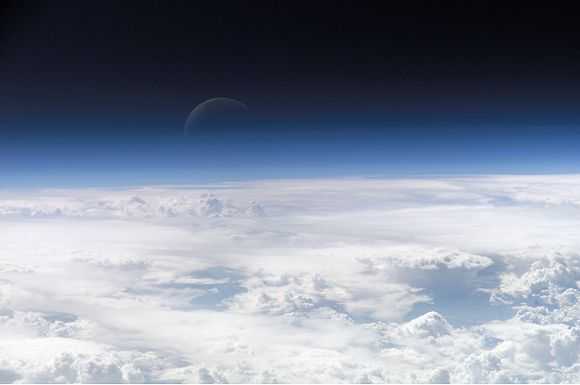Stellar atmosphere
The stellar atmosphere is the outer region of the volume of a star, lying above the stellar core, radiation zone and convection zone. It is divided into several regions of distinct character:
- The photosphere, which is the atmosphere's lowest and coolest layer, is normally its only visible part.[1] Light escaping from the surface of the star stems from this region and passes through the higher layers. The Sun's photosphere has a temperature in the 5,770 K to 5,780 K range.[2][3] Starspots, cool regions of disrupted magnetic field lie on the photosphere.[3]
- Above the photosphere lies the chromosphere. This part of the atmosphere first cools down and then starts to heat up to about 10 times the temperature of the photosphere.
- Above the chromosphere lies the transition region, where the temperature increases rapidly on a distance of only around 100 km.[4]
During a total solar eclipse, the photosphere of the Sun is obscured, revealing its atmosphere's other layers.[1] Observed during eclipse, the sun's chromosphere appears (briefly) as a thin pinkish arc,[7] and its corona is seen as a tufted halo. The same phenomenon in eclipsing binaries can make the chromosphere of giant stars visible.[8]
See also
Notes
- ↑ 1.0 1.1 ""Beyond the Blue Horizon" – A Total Solar Eclipse Chase". 1999-08-05. Retrieved 2010-05-21.
On ordinary days, the corona is hidden by the blue sky, since it is about a million times fainter than the layer of the sun we see shining every day, the photosphere.
- ↑ Mariska, J.T. The solar transition region. Cambridge Astrophysics Series. Cambridge University Press. ISBN 978-0-521-38261-8.
- ↑ 3.0 3.1 Lang, K.R. (September 2006). "5.1 MAGNETIC FIELDS IN THE VISIBLE PHOTOSPHERE". Sun, earth, and sky (2nd ed.). Springer. p. 81. ISBN 978-0-387-30456-4.
this opaque layer is the photosphere, the level of the Sun from which we get our light and heat
- ↑ Mariska, J.T. The solar transition region. p. 60. ISBN 978-0-521-38261-8.
100 km suggested by average models
- ↑ R.C. Altrock (2004). "The Temperature of the Low Corona During Solar Cycles 21–23". Solar Physics 224: 255. Bibcode:2004SoPh..224..255A. doi:10.1007/s11207-005-6502-4.
- ↑ "The Sun's Corona – Introduction". NASA. Retrieved 2010-05-21.
Now most scientists believe that the heating of the corona is linked to the interaction of the magnetic field lines.
- ↑ Lewis, J.S. (2004-02-23). Physics and chemistry of the solar system (Second ed.). Elsevier Academic Press. p. 87. ISBN 978-0-12-446744-6.
The dominant color is influenced by the Balmer radiation of atomic hydrogen
- ↑ Griffin, R.E. (2007-08-27). Hartkopft, W.I.; Guinan, E.F., eds. Only Binary Stars Can Help Us Actually SEE a Stellar Chromosphere (1 ed.). Cambridge University Press. p. 460. doi:10.1017/S1743921307006163. ISBN 978-0-521-86348-3. Retrieved 2010-05-21.
|
|---|
| | Star | | |
|---|
| | Exoplanet | |
|---|
| | Planet | |
|---|
| | Dwarf planet | |
|---|
| | Satellite | |
|---|
| | See also | |
|---|
|


